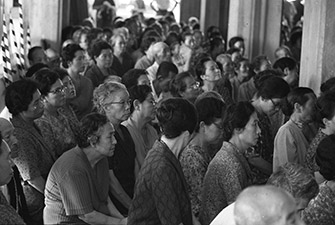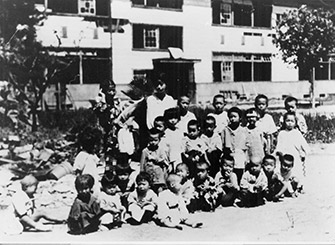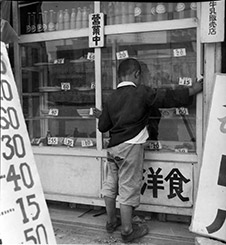The Flash Changed Everything
Not only did the bomb rob many of their lives, it also changed the lives of those left behind.
Besides the direct mental and physical suffering, many survivors lost the ability to support themselves. Unable to work due to injury, illness or discrimination, they faced severe financial hardship.
Though they tried to forget the flash, they were plunged into a harsh reality that kept the bombing continually before them.

Memorial service for mobilized student victims
There were over 6,000 mobilized students who died from experiencing the atomic bombing. In the 21st summer since the bombing, around 1,000 family members attended a memorial service for them. Even twenty years later, their feelings for their children hadn’t changed.
July 17, 1966
Tera-machi
Nishi Hongwanji Hiroshima Betsuin Temple
Photo by Yuichiro Sasaki
Courtesy of Yugo Shioura
Atomic Bomb Orphans
To protect them from air raids, the government evacuated children living in cities to surrounding villages. Under school evacuation guidelines, family members and acquaintances were encouraged to accept evacuees, but children without such alternatives were evacuated in groups to temples and other facilities.
Evacuations in Hiroshima City began in 1945. Pupils at elementary schools from third grade through sixth grade were evacuated to Futami, Yamagata, Asa, Takata, Saeki, Hiba, and Sera counties in Hiroshima Prefecture. The total number of children evacuated exceeded 20,000.
Although the evacuated school children were spared the bombing, many lost their parents. Some were left with no relatives at all.
No accurate count was possible, but these ‘A-bomb orphans’ numbered between 2,000 and 6,500. With the people of Hiroshima reduced to eating balls of grass and weeds found in the burnt wasteland, no one had time to do an official survey.
Children with no surviving relatives were taken in by such facilities as the Hiroshima War Orphans Foster Home. Some children, unable to adapt to life in an orphanage, ran away, while others never got the opportunity. Having to survive on their own, many fell into a life of crime.
Life at an orphanage was hard. The major problem was food. Significant support for the children living in these facilities came in the form of relief supplies sent from abroad, including the Moral Adoption program through which sponsors provided for the wellbeing of orphans.

Lost Children’s Center
A Lost Children’s Center was set up on August 8, 1945 at Hijiyama Elementary School and children who had lost their houses and relatives lived there.
Around the end of 1945
Shinonome-cho (now, Kami-shinonome-cho)
Schoolyard at Hijiyama Elementary School
Photo by Toshio Kawamoto
Courtesy of Yoshio Kawamoto

Boy on the street
Even 10 years after the war, boys like this one could be found here and there throughout Hiroshima.
(“Hiroshima since August 1945” by Yuichiro Sasaki, the Asahi Shimbun Company)
1954
Near Hatchobori
Photo by Yuichiro Sasaki
Courtesy of Yugo Shioura
